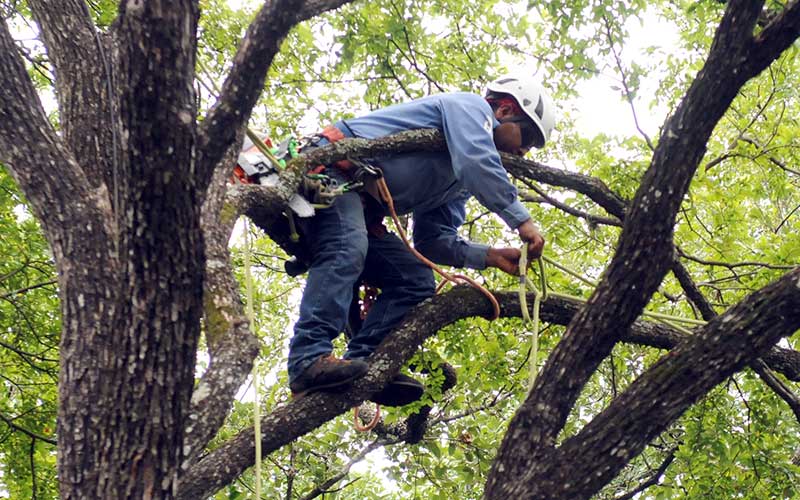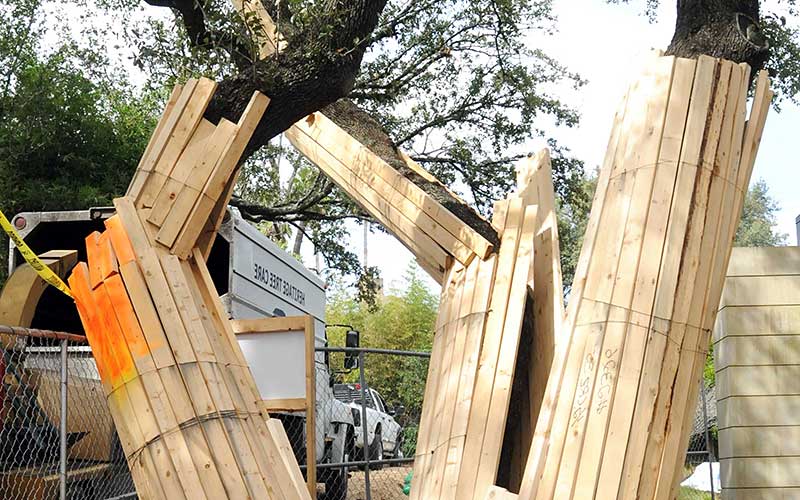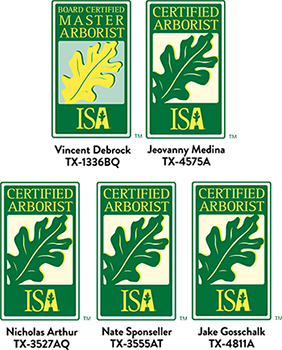By Vincent Debrock, Board Certified Master Arborist, TX-1336BQ
What question do arborists in Central Texas hear most often? “Is it okay to prune oak trees right now?” People ask for a good reason—they fear losing their oak trees to oak wilt disease. Oak wilt is a serious, contagious disease that kills most oaks it infects. And specific times of year and certain practices affect the spread of oak wilt.
If you own or work with oak trees in Austin or Central Texas, you’ve probably asked yourself one of these common questions:
2. What are common signs of oak wilt?
3. Which trees are most affected by oak wilt?
5. How can we prevent oak wilt transmission?
6. Can you explain the regulations regarding seasonal pruning bans?
7. Can I prune my oak tree right now in Central Texas?
8. Should I paint pruning cuts on my oak trees?
9. If oak wilt affects my tree, will it die?
10. How can I protect my property from oak wilt?
What is oak wilt?
Oak wilt is a fungal disease caused by the fungus, Bretziella fagacearum, which develops in the outer sapwood of the tree. It affects the tree’s ability to absorb and transport water and nutrients.
The infected tree reacts to the disease by creating internal structures that serve as plugs. This defensive reaction is meant to keep the disease from spreading, but it restricts the flow of water and nutrients. The tree wilts and usually dies.
By the time the tree dies, the disease has spread throughout the tree. The disease fungi produce spores that can be carried to other trees.
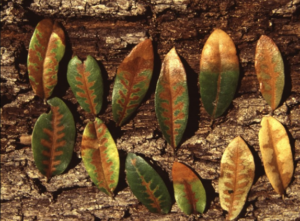
Image by Texas A&M Forest Service.
What are common signs of oak wilt?
A frequent sign of oak wilt is seeing multiple live oaks in an area dropping their leaves and declining rapidly. You might see one or more trees with leaves showing signs of vascular necrosis, the death of the tissue that transports water and nutrients. It often looks like a fishbone pattern on each leaf.
A common sign of oak wilt in red oaks is a rapid browning of the leaves out of season. If you notice unusual leaf color changes outside of autumn, it may indicate oak wilt.
Which trees are most affected by oak wilt?
All oak trees can get oak wilt, but some are more susceptible to the disease.
In Central Texas, the most affected species are the escarpment live oak, Quercus fusiformis, and Hill Country red oak, Quercus bucklei. All the trees in the red oak group, including blackjack and Shumard oaks, are more susceptible than white oaks.
Experts have found oak wilt in over 76 Texas counties and in most cities in Central Texas.
How does oak wilt spread?
Sap-feeding beetles can spread oak wilt. The fungi produce a sweet smell that attracts beetles who enter the tree through open wounds. The insect carries sticky spores to another tree while feeding on the fungus or sap.
The disease also spreads through connected roots from an infected tree to another of the same species. Escarpment live oaks, Quercus fusiformis, found in Central Texas, tend to grow in groves or motts. The roots, which graft into each other, can join all the trees in the group.
The spread of fungus via the roots is the primary source of infection. Oak wilt can spread 150 feet yearly, and red oaks can be linked underground to other trees 200 feet away. It’s a huge problem.
The Hill Country live oaks are much more vulnerable than the live oak, Quercus virginiana, in the coastal regions. Oak wilt along the Gulf Coast is rare since those trees seldom form the interconnected groves typical to escarpment live oaks.
Educating yourself about oak wilt, the signs of disease, and how to avoid it is the best preventive step to protect your trees.
How can we prevent oak wilt transmission?
We can only do a little to prevent root transmission in a dense urban setting. Trenching four feet deep to cut the root grafts is costly and complicated, and roots eventually grow across those trenches and re-graft.
What we can do is remain vigilant in areas where oak wilt is active. The best way to prevent transmission is to minimize pruning and clean tools well after each job. Disinfect before pruning each tree when the infection is present on your property.
Can you explain the regulations regarding seasonal pruning bans?
To help reduce the spread of oak wilt, some cities in Central Texas, including West Lake Hills, Rollingwood, and Lakeway, ban pruning on oak trees from February 1st to July 1st. The Texas Forest Service recommends no pruning on oaks during the spring because untrained tree trimmers are not knowledgeable about oak wilt prevention.
The City of Austin doesn’t have a city-wide pruning ban, instead focusing on oak wilt education campaigns and increased tracking of the fungus.
We encourage you to honor these recommendations or regulations but realize that professionals can help you determine when the pruning is an acceptable risk depending on your location and type of pruning needs.
People call our office to express concern when they see our crews pruning in the springtime. Usually, they need to realize we are pruning other tree species or doing an emergency pruning job. Trained, experienced arborists know when the likelihood of transmission is extremely low for that project’s location and type of pruning.
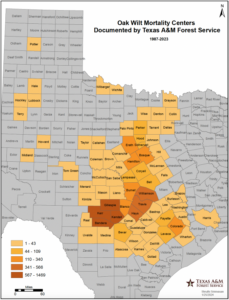
Map by Texas A&M Forest Service indicating areas with reported oak wilt. Click the image for more information from https://texasoakwilt.org.
Can I prune my oak tree right now in Central Texas?
Beetles can enter an oak tree from a natural wound, or one created by humans. Since pruning involves cutting, the open wound allows beetles to feed. These insects are most active from February through June when the fungus is likely to grow.
That is why we want to avoid as much pruning as possible during those months. If a contaminated beetle finds a fresh wound on a healthy tree, a center of infection can begin and destroy many trees.
The beetles and the fungus are the least active when it’s hot or cold, so winter and the heat of summer are safer. The growing seasons of pleasant weather in spring and fall are the most risky.
Trees and many insects become dormant when temperatures are below fifty degrees for three or more days. In Central Texas, that’s generally after Thanksgiving.
There is a second period of dormancy during the hottest months of summer. When daytime temperatures hit 100 for a few days, trees go dormant until the nights cool below 80 degrees. In early September, the oaks grow, and beetles become more active. So, stop most pruning until cold weather arrives.
Some pruning should be done during the growing season, despite the risk of oak wilt. Research shows that while trees are actively growing, cuts heal faster. When a wound seals quickly, decay and the likelihood of infection with the oak wilt virus are reduced.
Sometimes, sealing significant cuts can cause greater decay. It would be best if you made these decisions regarding major tree surgery with help from a certified arborist.
Should I paint pruning cuts on my oak trees?
Sealing the pruning cuts with paint may decrease the attraction of the sap-feeding beetles. Heritage Tree Care technicians immediately paint all cuts ¼ inch and larger after pruning.
When branches break from storm damage or other causes, it takes two or three days for a wound to seal. The first couple of hours are the most sensitive, as fresh wounds can attract the beetles. After a storm, broken limbs can cause increased infections depending on the season.
If oak wilt affects my tree, will it die?
If you’re concerned about the health of your trees, seek advice from an arborist. They can discuss preserving high-value trees with propiconazole fungicide injections. Fungicide does not stop root transmission of the disease, but it can save individual trees.
Texas Forest Service foresters have estimated around twenty percent of infected oak trees may survive. However, the canopy of the infected oak trees may be reduced and left unsightly for many years.
How can I protect my property from oak wilt?
Know where there are oak wilt infection centers in your area. These are typically clusters of trees near each other infected with the disease. If you have oak wilt in your area, you should be extra vigilant in protecting your trees.
Minimizing pruning during growing seasons is one way you can help protect your trees from oak wilt. Ensure you or contractors working on your property are aware of oak wilt and have protocols to prevent infections if they have to touch trees, e.g., disinfecting their tools and sealing cuts.
Planting a variety of tree species improves landscape resilience. When choosing new trees, consider which trees are already on your property and neighborhood. Diversity of tree species is our best defense against a changing climate and the overall health of Austin’s urban forest.
If you’d like to plant an oak, consider a post oak, chinquapin oak, bur oak, Monterrey oak, or Lacey oak. These varieties are part of the white oak group and are least susceptible to oak wilt. You can learn more about these and many other types of trees in our tree planting database.
Recommendations to reduce oak wilt transmission:
- Seal all cuts ¼ inch and larger on all oaks, all year long, quickly after pruning.
- Disinfect all pruning tools with Lysol or bleach.
- Use extendable poles to seal cuts from a distance.
- Schedule pruning, whenever possible, during the dormant season from mid-November to mid-February or the hot months of June, July, and August.
- If oak wilt is on site, disinfect tools between every single tree.
- Remove affected oaks from your property: chip, bury, or burn them.
- Talk to your neighbors and monitor oak wilt in your area.
Working together, we can preserve the valuable trees of Central Texas. If you’d like to learn more about the trees on your property, our ISA-certified arborists are available to evaluate your trees. They love to answer questions and provide long-term health care for your landscape. Call us at 512-921-8452 or contact us online to schedule an on-site visit with an arborist.
Learn more about oak wilt through these resources provided by Texas A & M Forest Service:
An Introduction to Oak Wilt
Eight-Step Program to Oak Wilt Management
Oak Wilt: Frequently Asked Questions

